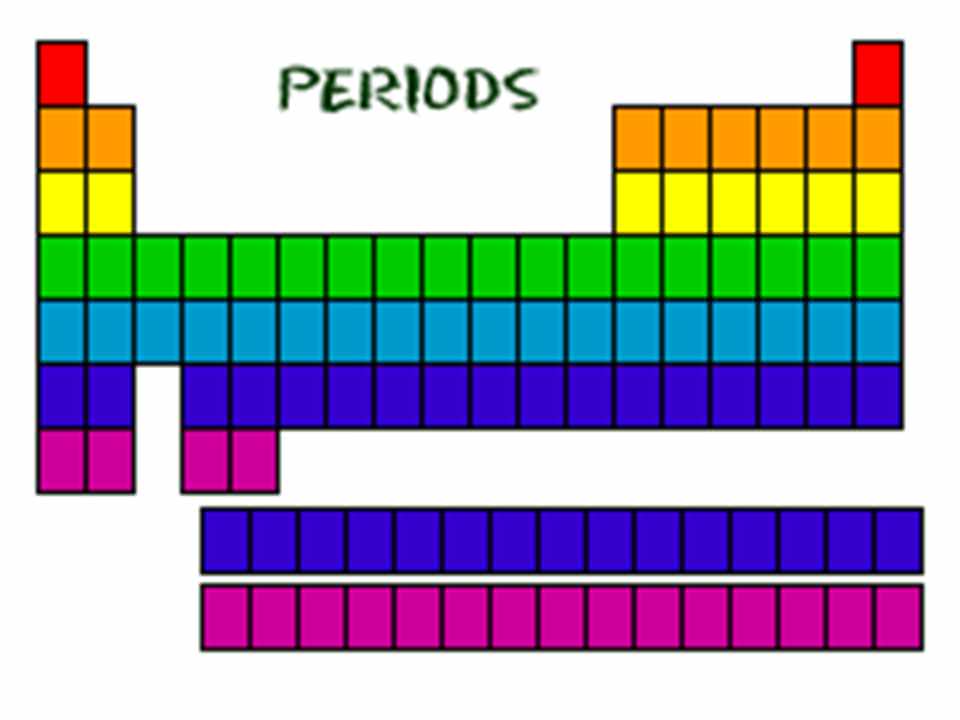The modern periodic table was constructed by the Russian chemist Dmitri Mendeleyev in 1869. The modern periodic table consists of horizontal rows called periods and vertical columns called groups. These are discussed below:
Periods in the modern periodic table

A period may be defined as horizontal row in the periodic table. In terms of electronic structure of the atom, a period constitutes a series of elements whose atoms have the same number of electron shells i.e. principal quantum number (n). Each successive period in the periodic table is associated with the filling of the next higher principal energy level (n = 1, n = 2, n = 3, etc.) There are seven periods and each period starts with a different principal quantum number.
Reading across a period from left to right, the number of electrons in the outer shell or subshell of the element increases.
Period 1 Elements
The first period corresponding to n = 1 is unique because it contains only two elements. First energy shell (K) has only one orbital (i.e. 1s) which can accommodate only two electrons. This means that there can be only two elements. Hydrogen (1s1) and Helium (1s2).
Period 2 Elements
The second period contains 8 elements because for n = 2, there are four orbitals (one 2s and three 2p) in second energy shell (L). In all, these four orbitals have a capacity of eight electrons and, therefore, second period has eight elements in it. It starts with lithium (Z = 3) in which one electron enters the 2s-orbital. The period ends with neon (Z = 10) in which the second shell is complete (2s2 2p6).
Period 3 Elements
This period contains eight elements from sodium (Z = 11) to argon (Z = 18).
Period 4 Elements
There are eighteen elements in fourth period from potassium (Z = 19) to krypton (Z = 36). In this period, we come across elements which involve the filling of 3d orbitals. These are known as transition series of elements. This starts from scandium (Z = 21) which has electronic configuration 3d1 4s2 and ends at zinc (Z = 30) with 3d orbitals completely filled having electronic configuration 3d10 4s2.
Period 5 Elements
The fifth period like the fourth period also consists of 18 elements. It begins with rubidium (Z = 37) with filling of 5s-orbital and ends at xenon (Z = 54) with the filling up of the 5p-orbitals. This period also contains 10 elements of 4d transition series starting at yttrium (Z = 39).
Period 6 Elements
The sixth period contain 32 elements (Z = 55 to 86). In addition to 10 elements of 5d transition series, this period contains 14 elements which involve filling up of 4f orbitals beginning from Cerium (Z = 58) to Lutetium (Z = 71). The series of elements are called inner transition series or lanthanoid series.
Period 7 Elements
The Seventh period is similar to the sixth period. Though expected to have 32 elements, this period is incomplete and contains only 29 elements at present. This period is expected to end at the element with atomic number 118, which would belong to the noble gas family. This period also contains 14 elements which involve the filling of 5f orbitals starting from actinium (Z = 89). This is also called 5f-inner transition series or actinoid series.
The first three periods containing 2, 8 and 8 elements respectively are called short periods, the next three periods containing 18,18 and 32 elements respectively are called long periods.
Test your understanding and answer these questions:
- What are lanthanoids?
- What are actinoids?
- What are alkali metals?
- What are alkaline earth metals?
- What are representative elements?
- What is transition series of elements?
- What is inner transition series of elements?
- How many periods are there in modern periodic table?
- What is definition of period in modern periodic table?
- How many elements are present in first period of modern periodic table?
- How many elements are present in second period of modern periodic table?
- How many elements are present in third period of modern periodic table?
- How many elements are present in fouth period of modern periodic table?
- How many elements are present in fifth period of modern periodic table?
- How many elements are present in sixth period of modern periodic table?
- How many elements are present in seventh period of modern periodic table?
